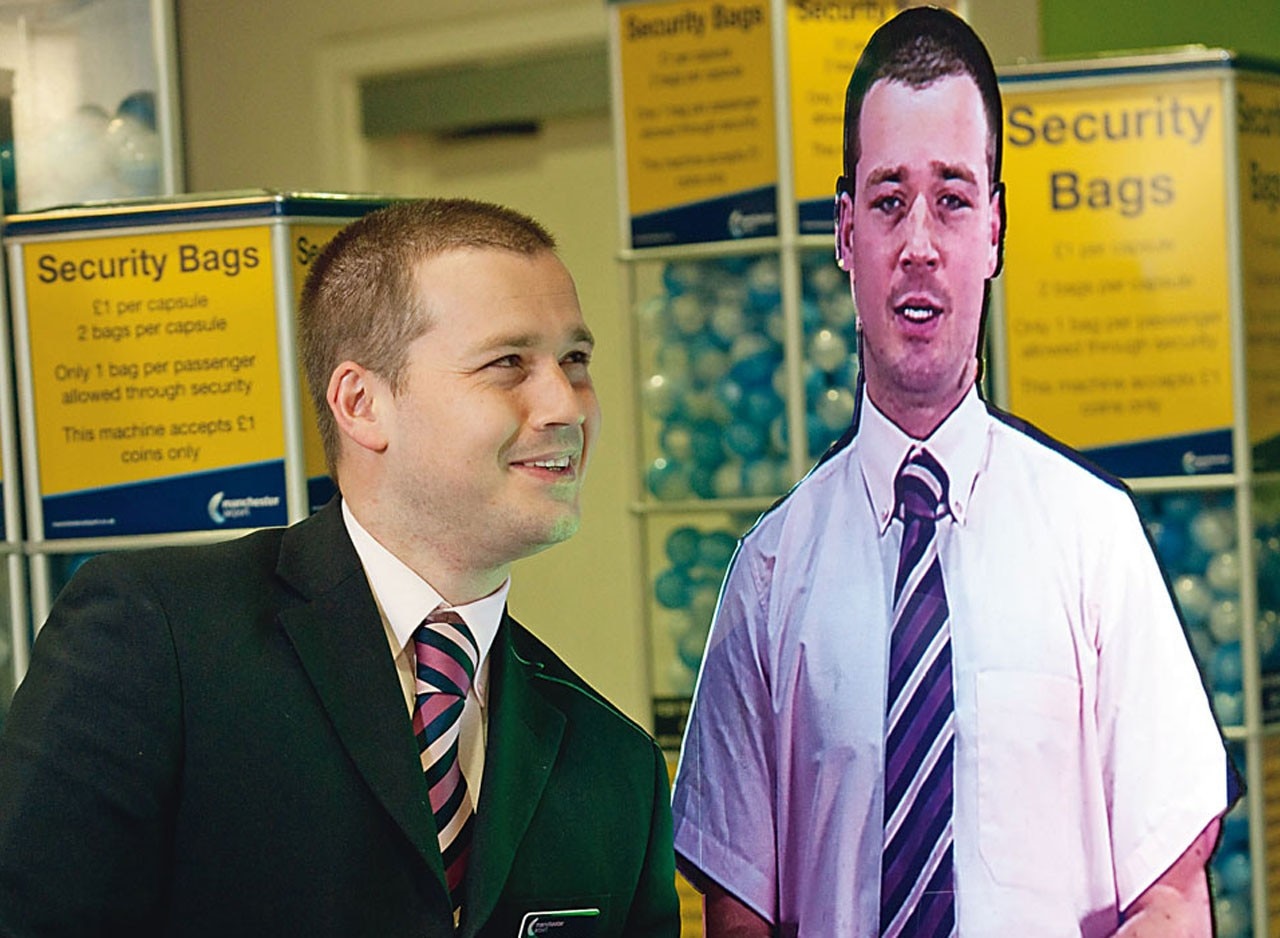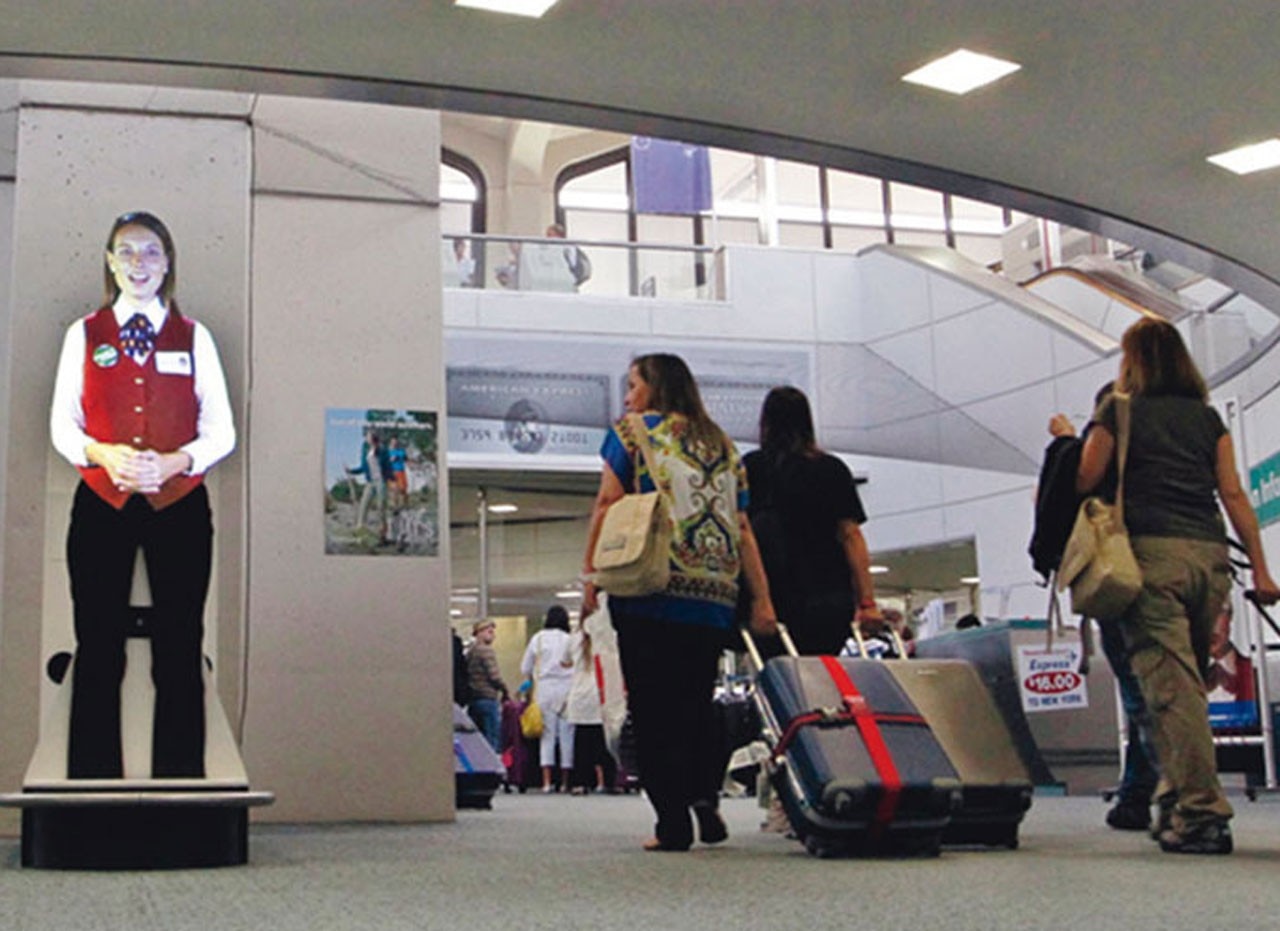This article was originally published in Domus 969 / May 2013
A few months back, in a particularly long queue to get to the departure area at Logan International Airport in Boston, I noticed a number of people ahead of me taking out their cameras, laughing, and pointing at something I couldn’t yet see. Once I snaked my way up to that point in the line, I came face to face with a young, uniformed, dark-haired woman standing above a platform instructing me on how to sort my laptop and other items for security clearance. A few steps more, and I could see the demarcations of her perimeter. The woman was two-dimensional, a projection on a human-shaped glass sheet.
The holographic announcer I met is named Carla. She is a product by Tensator®, a “queue control and management solutions” brand. Installed in June of last year, an aviation trade publication reported she cost the airport only 26,000 dollars. The avatar runs 24 hours a day and is portable so she can be moved to other areas of the terminal.

Carla is kind and calm in demeanour, with big eyes and a bright smile. Her resolution is so crisp one might mistake her for flesh and blood even at close distance. She greets you with folded hands before breaking into prestidigitation: a quart-sized clear plastic bag full of toiletries floats like magic into her flexed fingers. “Now that your liquid items are ready, let’s get you prepared for your departure security check,” she says. With an even bigger smile and a blink, she next appears with her jacket removed and instructs you to put your own neatly inside a tray. Her announcement lasts about four minutes and it is promptly repeated in Spanish. I watched her message run twice in full, only turning my eyes away as I finally stepped forward towards the backscatter machine.
There’s a reason why one of the most memorable and chilling episodes of The Twilight Zone involved mannequins coming to life at night. It is the same reason why robots cause a feeling of revulsion when they appear increasingly representative in human likeness. But we don’t apply the uncanny valley hypothesis to photographic documentation of real people. Hardly anyone feels aversion to the life-size cardboard cut-outs of grinning employees that sometimes greet you in banks, pharmacies and post offices. Holographic announcers like Carla seem to fall somewhere in between. She may not reside in the uncanny valley, but for the time being, Carla’s presence among the living is definitely uncanny.
You will find similar holographic announcers or “airport virtual assistants” in Dubai, Washington Dulles, Macau, Istanbul Ataturk and Long Beach, among other locations. AirportOne™, a competitor of Tensator®, which deployed several models to airports in New York and New Jersey last summer, says its models are only prototypes. The next step will be to install more interactive virtual assistants, which might answer basic questions from travellers about things like flight times, gates or rental car locations. Their plan is to provide models with a touch-screen interface next to the avatar rather than Siri-style speech technology. Voice recognition, while available in the more expensive models (roughly 100,000 dollars) isn’t recommended for airports due to the likelihood of interference from background noise. But AirportOne™ thinks it will be possible by next year.
AirportOne™ is testing a holographic announcer that uses a text-to-speech application
I spoke with Patrick Bienvenu, the Chief Operations Officer of Florida-based AirportOne™, who explained, “When you really have a message you want to get across, the avatar is a great way to get people’s attention. We’ve had a few people stop and say, ‘Oh, it’s freaky,’ but they get the message.” Bienvenu estimates that within five to ten years, people will get used to them, and by that time they will have more advanced technology and more advanced responsibilities.
I wondered who the people in the recordings were, and how they felt about their likeness used in this “freaky” way. The company hired professional actors and actresses “because facial expressions are everything”, but will not reveal their names. Their hologram twins may live on for quite some time since swapping the recording with updated content is costly and difficult to shoot. “It’s very difficult to get that model in precisely the same position again, with the same hairstyle, and the same body weight and everything,” Bienvenu explained. Cheaper holographic announcers tend to have a black border around the model, to allow for different shapes of projections. But that border sacrifices “a lot of realism”, he pointed out. “To make them look fairly real, we cut them really tight. You don’t see anything around the perimeter.”
And realism is the point. AirportOne™ is testing a holographic announcer that uses a text-to-speech application. Using still photography instead of a video recording, the look is animated rather than realistic. Even though this version is roughly the same price as the other, and its messages can be updated and customised instantly, there is far less demand for it. Bienvenu thinks text-to-speech avatars might be better off developed as smaller products, rather than life-size, since the animation already compromises authentic resemblance to a living human.

Early in 2011, the models “Jim” and “Julie” debuted in Manchester, UK, which, along with Luton, was the first airport to install holographic announcers. The company Musion created the holograms from recordings of actual members of airport customer service staff, John Walsh and Julie Capper. Newspapers reported several instances of confusion as Capper worked in the same section of the airport as her 2D video model. The airport also reports that travellers have attempted to hand their passports over to hologram Julie. Commenting on the product launch, Musion co-founder James Rock said, “We’ve been developing this technology [for] a number of years and we’d like to see its widespread use for practical purposes like the virtual assistants.”
Musion is better known for their less practical work: reviving dead celebrity singers. Their most famous project was the digital resurrection of Tupac Shakur at last year’s Coachella Festival. The company also recreated Frank Sinatra to perform at Simon Cowell’s 50th birthday party. When the Gorillaz played the Grammys in 2006, Damon Albarn and the other musicians performed off stage, while Musion Eyeliner technology animated Jamie Hewlett’s cartoon characters. For a Burberry runway show in Shanghai, Musion mixed holograms with real models. The projections walked right through each other or froze in place before disappearing in clouds of snow and smoke.
Musion doesn’t shy away from the loaded word “resurrection” in the promotional material on its website. There it points out that “lost artists often increase in popularity after they pass so for holders of estates, the business potential is huge. However, more important is sharing amazing musicians with fans who’d expected never to see their idols again.” Immediately after the Tupac hologram, speculation began as to which performer might be resurrected next—Jim Morrison? Kurt Cobain? Jimi Hendrix? Surviving members of tlc are reportedly mulling over the possibility of a Lisa “Left Eye” Lopes hologram for a reunion tour.
While the ethics behind holograms of deceased celebrities might be questionable (in the words of a parody Twitter account called Aaliyah’s Ghost, “The best duets imo are the ones where both artists are alive & agreed to work together”), copyright permissions and objections from various estates, in addition to the high costs, have so far prevented “resurrections” from becoming a more widespread trend. For its closing ceremony, the London Olympics scrimped on costs, reviving Freddie Mercury for a duet with Jessie J by broadcasting his image on a flat screen rather than a hologram body. It is hard to imagine the Tupac hologram moving forward without permission from his mother Afeni Shakur. The Marilyn Monroe estate, on the other hand, contested plans for a “Virtual Marilyn” concert organised by Musion partner Digicon Media.

As many pointed out after the Coachella performance, “hologram” is not quite the proper way to describe what occurred on stage. The projection was an updated Pepper’s Ghost parlour trick, like the kind you see in the Haunted Mansion at Walt Disney World®. The Musion Eyeliner begins with a projection from above facing down on a mirrored floor surface, which is then reflected on a transparent foil, angled forward away from the stage so it will appear invisible to the audience. Airport virtual assistants aren’t quite holograms either, but less complicated, these are rear projections upon flat sheets of glass.
The spectacle of an airport virtual assistant seems even more unsettling than Tupac beamed back to life from the dead. For rather than stagecraft, it is an object right in front of you, taking up space in the environment no different from an actual human being. It is easy to see why airports would favour these human-like models instead of simply broadcasting video recordings on ordinary flat screens. There’s something infectious about the hologram’s upbeat energy. One is tempted to smile back at the machine. And the novelty keeps your eyes on it. When I came upon another airport hologram more recently in Athens, I watched a small child run to it and try to reach up to grab it.
There is the pretence of a hologram as an individual—without a twin, either as a living person or as a duplicate product. If it didn’t matter, all major cities might install Mick Jagger holograms in their stadiums. But these virtual assistants are representations of real people, presumably still alive, frozen in time. In Athens, I wondered if maybe the young man who modelled for this product has seen his holographic doppelganger in the wild. Fluent in Greek, as he is, it seems likely this would be his home airport. For years, he may be confronted with this life-like version of his youth. The hologram might even outlive him.
Airports could, if they wanted to, use Gorillaz-style characters as projections instead of people. Or the holograms could dissolve into smoke like Musion’s Burberry runway models. For now the only whimsy these products bring to airports are the tiny illusions like Carla offered, making quart-sized clear bags appear from thin air. A major benefit of the technology is the unique opportunity to make abstract or fantastic ideas appear lifelike before our eyes.
It seems some creative liberty here may be wasted.
Or perhaps these avatars don’t want to flaunt their superhuman abilities beyond their more obvious advantage over the living. The virtual assistants don’t get tired and they never complain. A hologram won’t slap you if you try to put your arm around it. It doesn’t need a bathroom break.
A major benefit of the technology is the unique opportunity to make abstract ideas appear lifelike
AirportOne™’s brochure explains that an avatar “works 24 hours, 7 days a week and never takes a break! No background check required!” The one-time cost to purchase a hologram is already about as low as a customer service representative’s annual salary. The company is looking to expand beyond airports and shows hologram models for a doctor’s office (a man in a white coat, with a stethoscope around his neck) or a museum, with a model dressed in what looks like a store-bought Egyptian princess costume. They also report interest in similar models to use at trade shows.
Holographic announcers might be a good investment for the high-street sandwich shop Pret A Manger®, which recently came under fire for its strict policies governing the personalities and behaviour of its workforce. In company memos, the international fast-food chain demands its workers complete shifts in good spirits. The company will never hire a person who “overcomplicates ideas” or is there “for the money”. Sociologists call this part of the job “emotional labour”: the facial and bodily display towards a customer, which is often under-compensated as it is difficult to put a dollar value upon. Elusive to quantitative measure, it is nevertheless a substantial guiding factor in transactions. In an essay on the subject for In These Times, writer Sarah Jaffe discusses how Pret’s policy justifies low wages by maintaining the fallacy that “enjoyment of the job is its own reward”. Never mind that sometimes an employee’s bad attitude is the canary in the coalmine exposing structural problems in a work environment.
Hiring decisions taking into consideration the relative attractiveness of public-facing employees are similarly fraught with inexpressible complications. But a single day filming a professional actor or actress, dressed and made up for the occasion, avoids direct exploitation of a worker’s appearance. A travel piece for the CNN website even debates whether London or New York used “hotter” hologram models. Although Manchester filmed actual airport staff, newer holographic announcers look like photogenic locals. A hologram in Dubai greets travellers in dishdasha, agal and shemagh. Carla is ambiguously ethnic, appropriate to Boston’s international population.
Will the novelty wear off eventually? Could further interactivity compromise the authenticity of these holograms? The manufacturers clearly wish for us to view their creations as humanoid rather than expensive toys. As prerecorded short messages, these products are currently safe from the ultimate departure from realism—communication break-down.
Realistic in appearance as they may seem, these projections of actors and actresses in airport uniforms earn no empathy. That I offer to the human beings standing in the shadows of the holograms. Where are those workers going to go if the holograms take over? I’ll miss their scowls and eye rolls, the appropriate response to security theatre. Only a hologram can take airport rules on liquids and removing shoes seriously. Joanne McNeil (@jomc) Writer in New York



